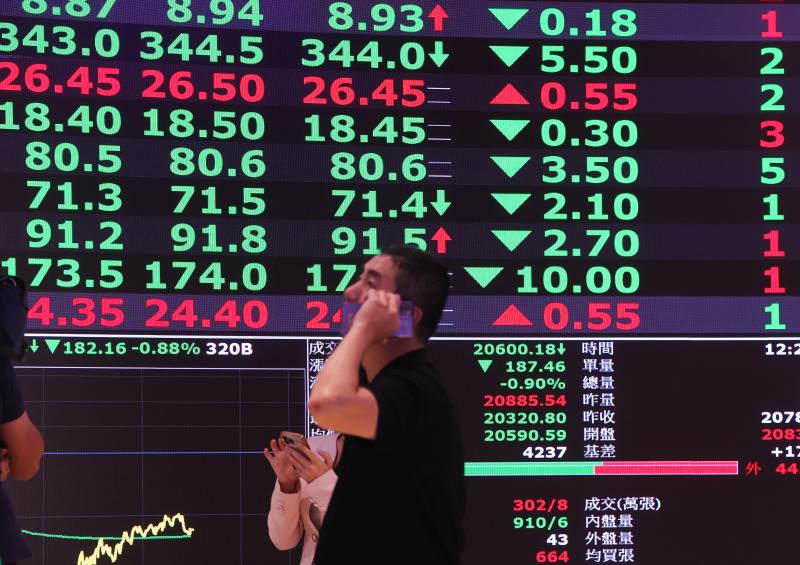The New Taiwan dollar showed signs of stabilizing yesterday after a recent surge, but local shares still closed slightly lower as investors remained concerned over possible US tariffs on semiconductor imports.
The NT dollar reversed its steep rise in the previous two sessions, closing down NT$0.135, or 0.45 percent, at NT$30.280 against the US dollar in Taipei trading.
The NT dollar led volatile moves in Asia earlier this month, surging as much as 5 percent against the US dollar on Monday, its biggest single-day gain since the 1980s.

Photo: CNA
The rally was fueled by exporters rushing to convert US dollar holdings and signs that life insurers might have been hedging their greenback-denominated portfolios.
However, it edged lower yesterday amid a broader pullback in Asian currencies.
Central bank Governor Yang Chin-long (楊金龍) on Monday said that speculative activity had driven the sharp appreciation, prompting the bank to intervene early this month.

Photo: CNA
Yang attributed part of the sharp rise to analyst statements that the NT dollar might rise, calling for them to tamp down their chatter.
President William Lai (賴清德) and the Cabinet’s Office of Trade Negotiations have denied that the currency has been discussed during talks with the US, which has threatened to impose a 32 percent tariff on Taiwanese exports.
While the local currency stabilized after its sharp rally earlier this week, the TAIEX closed down 10.40 points, or 0.05 percent, at 20,522.59 yesterday, as concerns over potential US semiconductor tariffs weighed on sentiment.
After opening down 179.11 points, the market rebounded and reached its intraday high just before noon. However, selling pressure intensified later in the session, particularly in large-cap semiconductor stocks, dragging the TAIEX into negative territory by the close.
“Investors seemed relieved to some extent after the central bank, the largest player in Taiwan’s currency market, said volatility was over,” Mega International Investment Services Corp (兆豐國際投顧) analyst Alex Huang (黃國偉) said.
However, “possible tariffs on semiconductors returned to hurt sentiment. So Taiwan Semiconductor Manufacturing Co [TSMC, 台積電] came under pressure, dragging the broader market lower,” he said.
TSMC, the world’s largest contract chipmaker and also the most heavily weighted stock on the local main board, lost 1.92 percent.
However, easing concerns over the impact of currency fluctuations on insurers’ overseas assets lent support to the financial sector.
Cathay Financial Holding Co (國泰金控) rose 2.19 percent, while E.Sun Financial Holding Co (玉山金控) gained 2.69 percent. In contrast, Fubon Financial Holding Co (富邦金控) slipped 1.25 percent.
With the NT dollar’s unprecedented two-day rally subsiding, investor attention is now turning to the US Federal Reserve’s policy meeting today.
While the Fed is widely expected to keep rates unchanged, the meeting might be the last with such a clear-cut outcome.

Taiwan Semiconductor Manufacturing Co (TSMC, 台積電) last week recorded an increase in the number of shareholders to the highest in almost eight months, despite its share price falling 3.38 percent from the previous week, Taiwan Stock Exchange data released on Saturday showed. As of Friday, TSMC had 1.88 million shareholders, the most since the week of April 25 and an increase of 31,870 from the previous week, the data showed. The number of shareholders jumped despite a drop of NT$50 (US$1.59), or 3.38 percent, in TSMC’s share price from a week earlier to NT$1,430, as investors took profits from their earlier gains

In a high-security Shenzhen laboratory, Chinese scientists have built what Washington has spent years trying to prevent: a prototype of a machine capable of producing the cutting-edge semiconductor chips that power artificial intelligence (AI), smartphones and weapons central to Western military dominance, Reuters has learned. Completed early this year and undergoing testing, the prototype fills nearly an entire factory floor. It was built by a team of former engineers from Dutch semiconductor giant ASML who reverse-engineered the company’s extreme ultraviolet lithography (EUV) machines, according to two people with knowledge of the project. EUV machines sit at the heart of a technological Cold

Taiwan’s long-term economic competitiveness will hinge not only on national champions like Taiwan Semiconductor Manufacturing Co. (TSMC, 台積電) but also on the widespread adoption of artificial intelligence (AI) and other emerging technologies, a US-based scholar has said. At a lecture in Taipei on Tuesday, Jeffrey Ding, assistant professor of political science at the George Washington University and author of "Technology and the Rise of Great Powers," argued that historical experience shows that general-purpose technologies (GPTs) — such as electricity, computers and now AI — shape long-term economic advantages through their diffusion across the broader economy. "What really matters is not who pioneers

TAIWAN VALUE CHAIN: Foxtron is to fully own Luxgen following the transaction and it plans to launch a new electric model, the Foxtron Bria, in Taiwan next year Yulon Motor Co (裕隆汽車) yesterday said that its board of directors approved the disposal of its electric vehicle (EV) unit, Luxgen Motor Co (納智捷汽車), to Foxtron Vehicle Technologies Co (鴻華先進) for NT$787.6 million (US$24.98 million). Foxtron, a half-half joint venture between Yulon affiliate Hua-Chuang Automobile Information Technical Center Co (華創車電) and Hon Hai Precision Industry Co (鴻海精密), expects to wrap up the deal in the first quarter of next year. Foxtron would fully own Luxgen following the transaction, including five car distributing companies, outlets and all employees. The deal is subject to the approval of the Fair Trade Commission, Foxtron said. “Foxtron will be